Did you know that top smartphone manufacturers continue to make those seemingly outdated push-button cell phones? They’re often dubbed ‘granny phones.’ While we strive to combat ageism in society, it persists. Individuals in their later years often resist changing their customary practices.
But does our brain truly diminish with age, or is this belief a social myth that needs to be dispelled?
According to the transformative learning theory, there is a bit of truth to the notion that our ability to study changes with age. However, the cause is not rooted in the natural processes of our brains. Instead, it is tied to our enduring self-image and outlook on life. Indeed, the saying “your mind is your own limit” is grounded in science.

Everything can be remedied. Transformative learning offers innovative education approaches. It aims to modify established patterns of behavior and interaction with the world. Thus, the first step is to let go of your inner limitations and open your mind to new information. This article will guide you through this complex journey.
Curious? Let’s dive into the details:
- You’ll gain a comprehensive understanding of what transformative learning entails.
- We will debunk the myth that it’s ever too late to learn.
- Finally, we’ll provide you with examples and techniques of transformative learning to excel in the classroom, regardless of age.
📙 What Is Transformative Learning About?
Every living creature learns from experiences, but only humans can rationalize them. Our education extends beyond absorbing mere facts. It profoundly transforms us, shaping our inner world and character.
Learning a foreign language exemplifies the transformative power of education. Researchers at Stockholm University believe that your attitude towards a language and its cultural context can shape your personality when you speak that language.
Transformative learning is a frequently used term in andragogy (adult learning). This approach is designed to help adult students optimize their memory efforts and further develop their personalities.
Jack Mezirow’s transformative learning theory posits that to assimilate new information, we need to re-examine our previous beliefs. This critical reflection alters our worldview, prompting us to challenge our existing knowledge. The fresh perspective, in turn, paves the way for new information and insights.
Intrigued? There’s more to come!
⌛ Can It Ever Be Too Late to Learn?
The ability to learn was critical for our survival long before the establishment of the first school. Humans are born without the ability to find food, communicate, or even walk. Our ancestors acquired these skills by mimicking their parents. Intriguingly, little has changed over the past several millennia.
Meanwhile:
Sharing and accumulating knowledge across generations became more crucial for humans than other species. Learning emerged as a vital skill for survival, given that we lack horns or claws for defense. Those who could not keep pace with the tribe faced dire consequences.
However, the environment evolved at a gradual pace. The body of knowledge was limited enough for one person to grasp within a lifetime, and our average lifespan was half of what it is now. Once children acquired the knowledge their parents possessed, there was little need to update it.
Today, the available information grows exponentially, doubling every year.
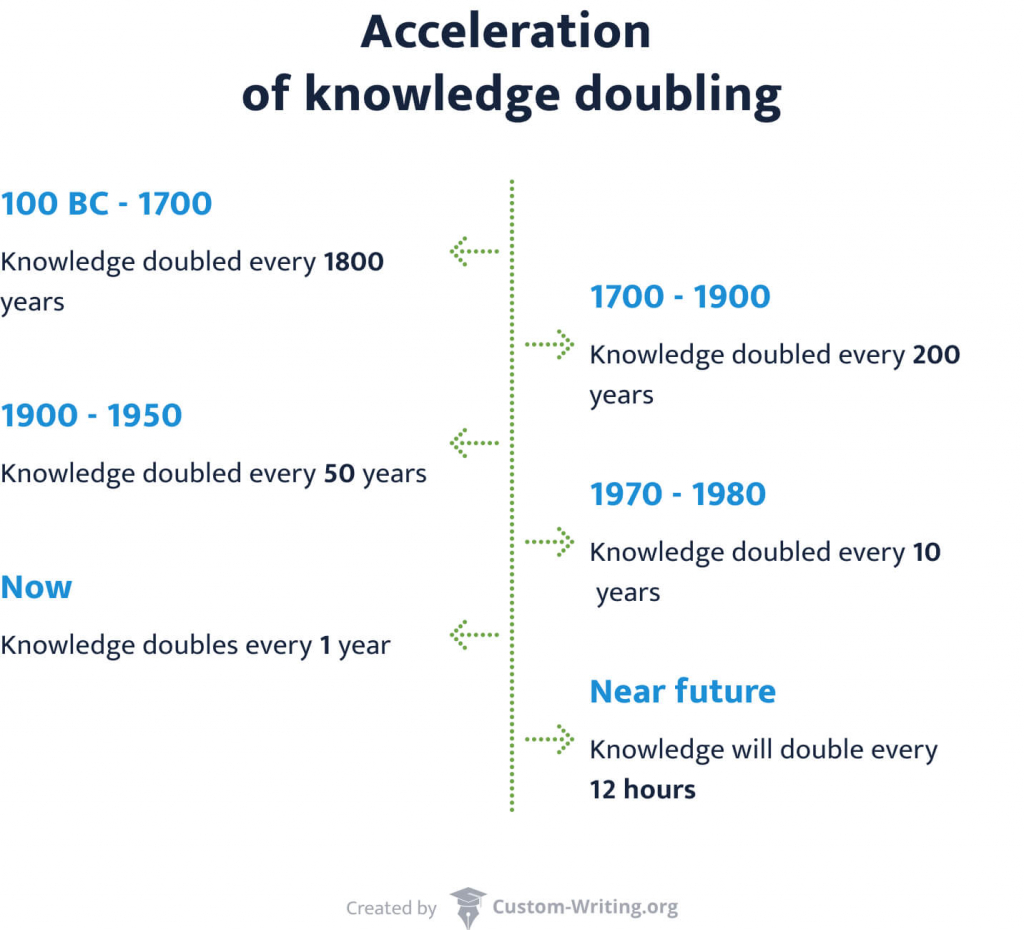
Even if we may not need 99% of the available data, the chances of needing to re-profile yourself are high. Age can introduce health conditions that might render your current career impossible. Many jobs become obsolete, making your skills irrelevant in the modern job market. Even if none of the above occurs, you still need to stay updated with cutting-edge technologies and the latest research in your field.
Socrates likened human memory to a wax tablet where one can write, erase, and write again. However, with each use, its plasticity decreases, making writing increasingly difficult.
A common belief holds that as we age, learning becomes more challenging:
- Neuroplasticity diminishes,
- Cognitive functions decelerate,
- The brain shows wear.
However, no current research supports this notion.
Most research yields mixed results. Indeed, certain aspects of learning, such as conscious recollection, deteriorate. However, others, like implicit memory, remain unchanged. These declines can be offset by strong study habits and motivation, which often intensify with age.
Another study indicates that configural response learning (i.e., our ability to recall complex relationships between elements) remains intact throughout our lives. Moreover, these findings contradicted the researchers’ initial assumptions.
If you are still skeptical about the learning efficiency of adult students, consider this compelling point:
Learning has been proven to be highly beneficial for an aging brain. It serves as a preventative measure against Alzheimer’s disease and certain other forms of dementia. Moreover, it adds purpose to our lives.
It is never too late to learn. But why does it seem so challenging once we’re no longer students?
🔤 Transformative Learning Theory: The Basics
We are shaped by our upbringing, experiences, education, and culture. Transformative learning theory posits that each unique combination forms an individual’s worldview. Our understanding of why the world functions in a certain way becomes deeply ingrained and resistant to change. Over time, beliefs solidify into habits that often go unnoticed. Yet, education, coupled with significant life-altering events, remains a potent tool to challenge this status quo.
Jack Mezirow suggests a specific approach to streamline this transformative process for adult students.
He argues that education starts with a disorienting dilemma, prompting individuals to reevaluate their worldview. This realization triggers a series of processes we will describe below. But first, let’s explore the historical context.
The Origins of Mezirow’s Approach
It was the early 1970s when Mezirow’s wife, Edee, enrolled at Sarah Lawrence College, planning to complete her undergraduate education after a long break. Inspired by her experience, Mezirow conducted an extensive study of women returning to their studies at US community colleges. His goal was to identify factors that either hindered or enhanced adult learning, aiming to help other students in their academic pursuits.
The Roots of Transformative Learning Theory
Mezirow did not develop his theory in isolation. He built upon the work of those who had explored similar paths. A series of foundational research underpins his ideas, the essentials of which are outlined in the following subsections.
Freire’s Critical Consciousness
Paulo Freire compared traditional education with a banking system. In this model, teachers “deposit” knowledge into students’ minds, failing to teach them how to think independently. While these facts can be recalled, they are of little help once the context changes.

Freire believed that education should raise awareness of global issues while also empowering students to make a difference. He termed this “conscientization” – recognizing a problem and being prepared to address it.
Freire’s theory influenced Mezirow’s belief that mere knowledge acquisition isn’t sufficient, especially for adult learners. A transformational approach is essential.
Kuhn’s Paradigm
Thomas Kuhn differentiated between social and natural sciences in a rather unexpected way. He believed there was minimal overlap in what each discipline deemed as the proper approach to science. He called these varying approaches “paradigms,” or frameworks scientists use to make discoveries or solve problems.
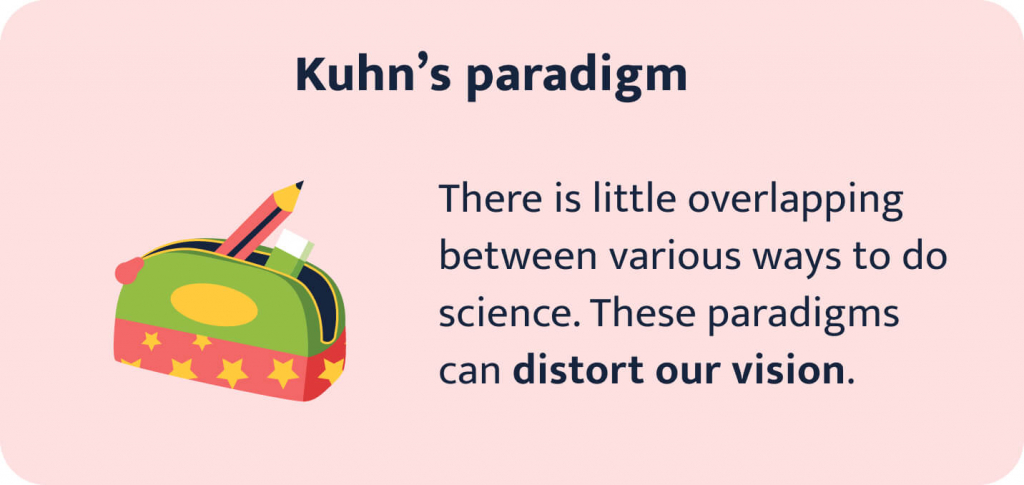
Later, Mezirow compared the paradigms to glasses that alter our worldview. While they can distort our perception, they can also enhance it. Transformational education aims to shift these paradigms.
Domains of Learning by Habermas
Jürgen Habermas classified learning into types:
- Teaching learning, where you learn the steps of a task;
- Practical education, which instructs you on how to behave in specific settings;
- Emancipatory learning, which prompts you to reevaluate your beliefs and the reasoning behind them.
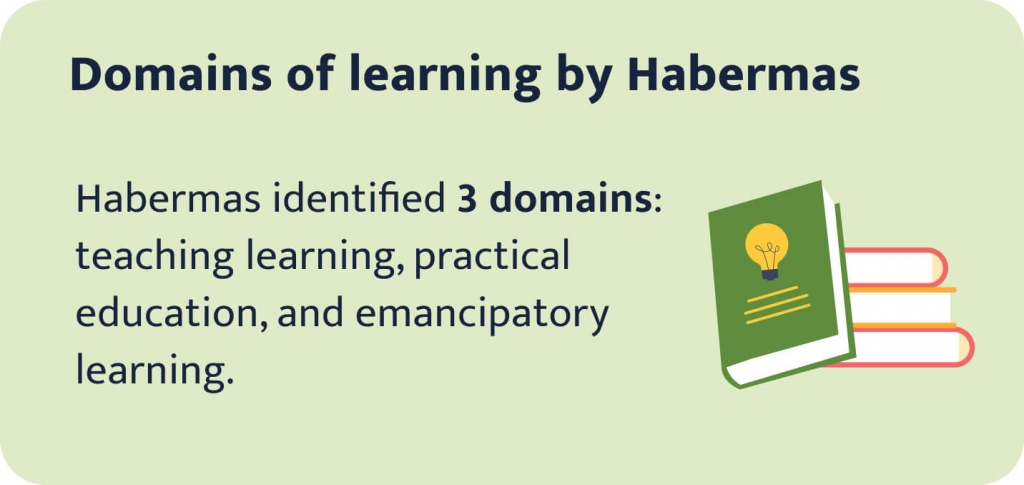
Habermas’ ideas complemented Mezirow’s theory like the missing piece of a puzzle. For individuals to evolve and change their habits, they must recognize their beliefs and the reasons behind them. This self-awareness leads to better choices and fosters greater innovation.
📍 10 Transformative Learning Phases
So, how does the process of transformative learning look exactly? Let’s dive into details.
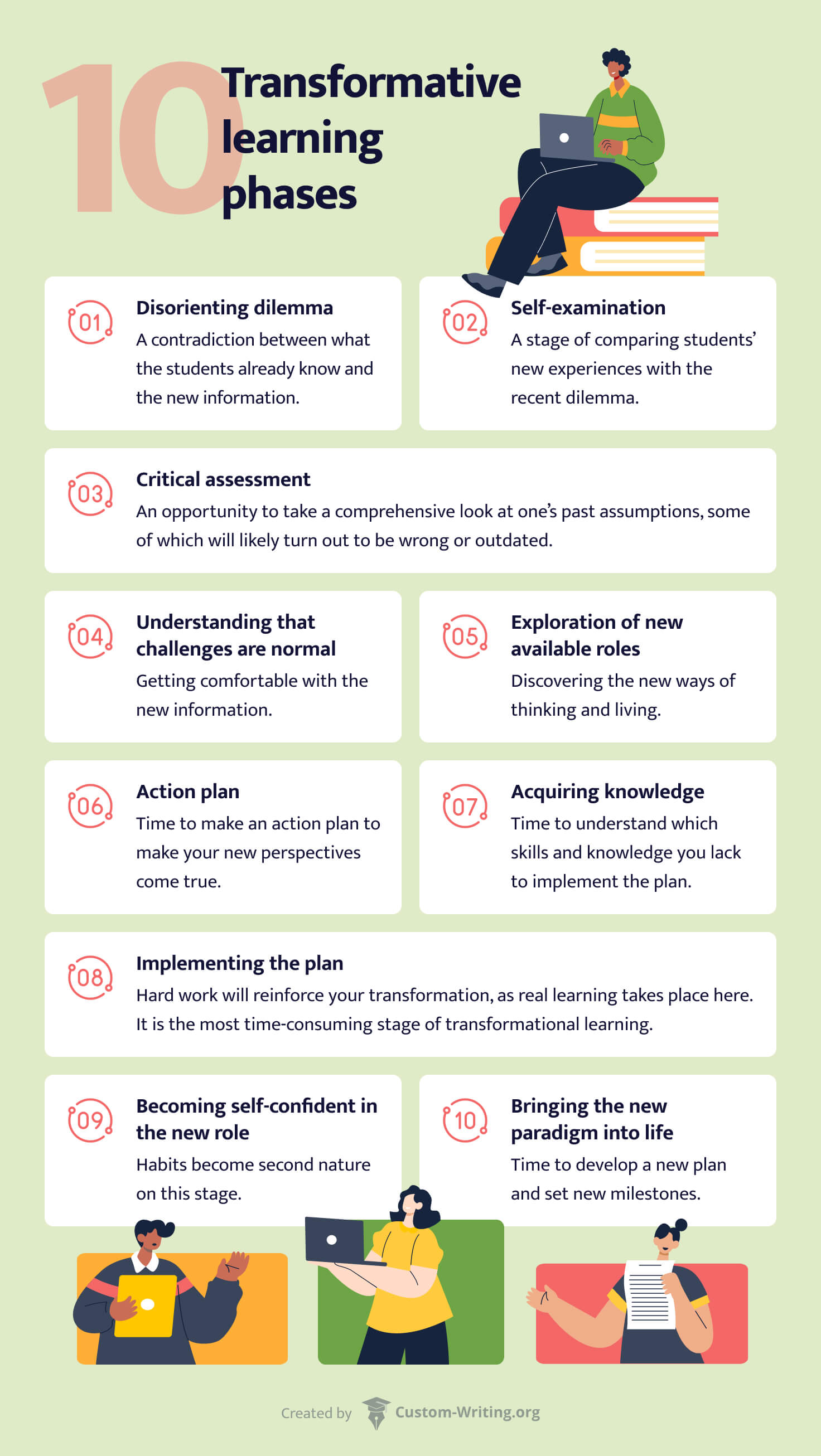
Phase 1 – Disorienting Dilemma
An adult returning to school discovers that the academic setting has different expectations than the professional world. It can be challenging to reconcile past experiences (which are extensive with age) with academic objectives. These students often encounter information that contradicts what they have previously learned.
This discrepancy creates a disorienting dilemma, paving the way for transformative learning.
Phase 2 – Self-examination
At this stage, students or self-learners juxtapose their new experiences with the recent dilemma. This introspection offers a broader perspective on the alternatives. However, it often brings feelings of anger, guilt, fear, or shame.
Don’t worry! These emotions will be processed during the transformative learning journey.
Phase 3 – Critical Assessment
There is no absolute truth, so it’s time to reevaluate your past assumptions. Some of them may prove to be incorrect or outdated.
The advantage of this stage is gaining an objective view of your past.
Phase 4 – Understanding that Challenges are Normal
The discomfort you felt in earlier stages is essential to your transformation. Take solace in the fact that others share your struggles and concerns. Replacing an old habit with a new one is inherently unsettling. Keep calm and carry on.
Phase 5 – Exploration of New Roles
If you have ever played a computer game, you know that acquiring new skills unlocks new possibilities. The once-daunting boss becomes a manageable opponent.
Explore the roles you’ve made for yourself to uncover alternative ways of thinking and living.
Phase 6 – Action Plan
You’ve identified where you were wrong and discovered new perspectives. Now, it’s time to make an action plan to realize these insights. Establish milestones for self-assessment and anticipate potential challenges along the way.
Phase 7 – Acquiring Knowledge for the Plan
What advanced learning is required to continue with your development? With a clear goal in mind, encountering new disorienting dilemmas becomes less likely. However, as you execute your plan, you will recognize areas where you lack specific skills and knowledge. Be prepared to revisit this stage as needed.
Phase 8 – Implementing the Plan
Theory transitions to practice. Hard work will solidify your transformation as genuine learning takes place at this juncture. This is the most time-consuming and demanding stage of transformational learning.
Phase 9 – Becoming Self-Confident in the New Role
You have actively pursued new experiences. Over time, you start to feel comfortable doing familiar tasks in novel ways. These habits become second nature.
Phase 10 – Bringing the New Paradigm into Life
Now, you have transformed into a different person with altered perspectives on various topics. Now, it is time to develop a new plan and set fresh milestones.
Conversely, your partner and relatives might question why you have changed so significantly. This can happen when only one member of a social group undergoes moral and intellectual growth. A heartfelt conversation reassuring them of your love can help. If needed, suggest they read about transformative learning and offer support during their disorienting dilemma phase.
📝 6 Transformative Learning Techniques
How does this all translate in practice? Below, discover practical learning techniques to accelerate your intellectual growth.
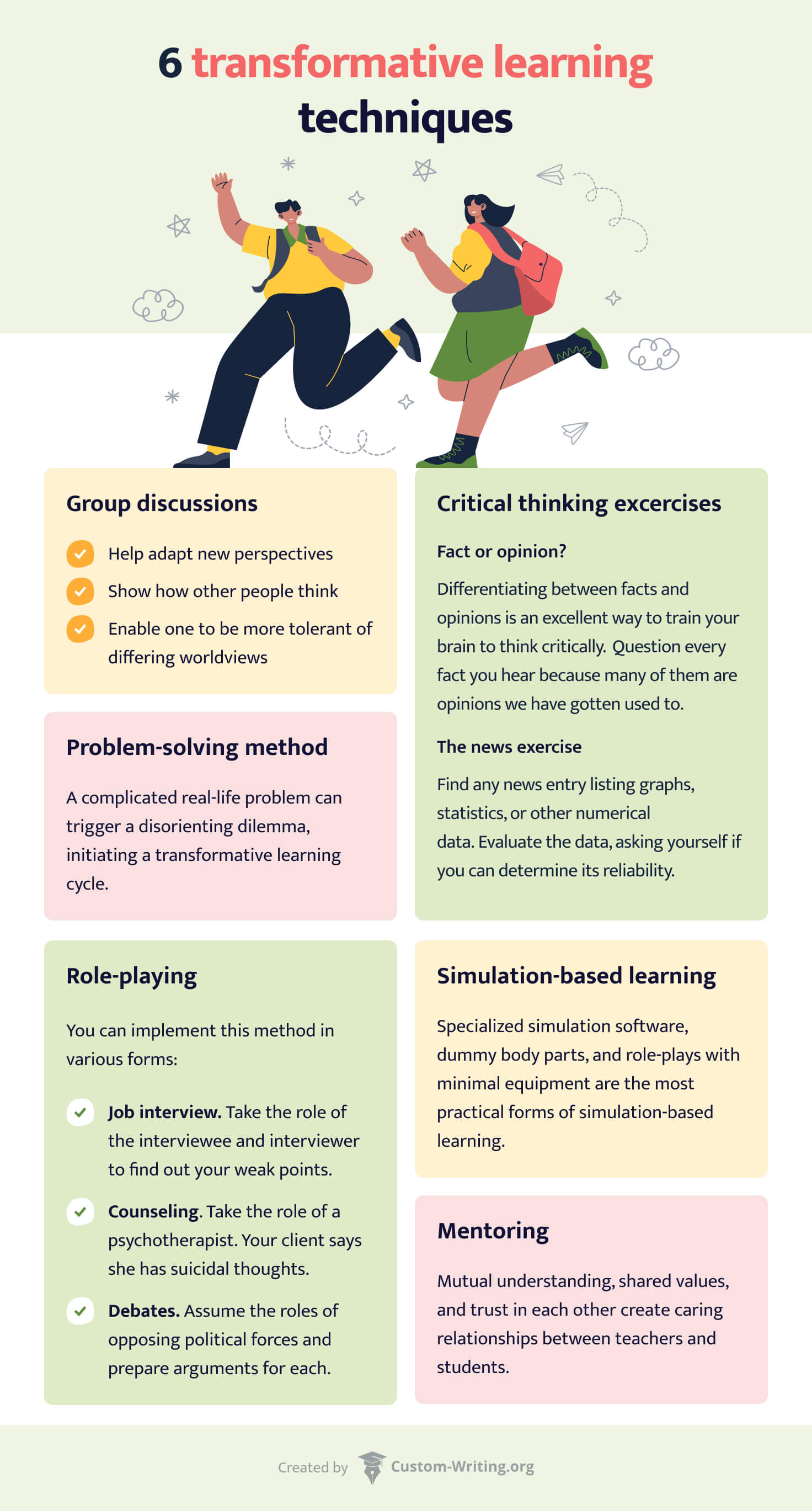
Critical Thinking Exercises
Critical thinking, open-mindedness, and the ability to break free from habitual patterns are the essential skills you will gain through transformative learning. You can develop them with a modest time investment. The key is consistency and regular practice.
Below are a few suggestions.
Fact or Opinion?
In The Laws of Human Nature, Robert Greene lists several biases every human has. The first and the most common is the confirmation bias. We tend to seek out evidence that supports our views, dismissing any information that contradicts them.
Distinguishing between facts and opinions is an excellent way to train your brain to think critically. Read the statements below and determine which are facts and which are opinions.
- The US is larger than Great Britain in terms of area and population.
- Autumn is the best season to reconsider your life and develop a new strategy.
- Carrots are good for your health.
- Plants emit oxygen while processing carbon dioxide.
- Britney Spears is a pop singer, so her songs cannot be considered cultural heritage.
- You should treat your partner with respect.
A good rule of thumb is to ask yourself whether the statement is debatable. The sizes of the US and GB are indisputable since the numbers are available and can be easily compared. While treating our partner with respect is generally accepted, there are potential objections. What happens if respect is not reciprocated? Is this applicable to abusive relationships?
Question every fact you encounter, as many are merely opinions we have come to accept.
The News Exercise
Many people criticize the news as mere brain candy. However, it can be used to train our critical thinking. Look for any news article that includes graphs, statistics, or other numerical data.
- Does the accompanying text clarify the presented data?
- Does the data representation make sense?
- Can you evaluate the graph’s credibility?
- Can you determine the presenter’s reliability or potential bias?
- Can someone benefit from a particular interpretation of the data?
Distinguishing scientific data from manipulative news is a valuable exercise.
Group Discussions
Group discussions are a cornerstone in classrooms focused on transformative education. Such assignments offer an excellent opportunity to look at familiar concepts from new angles. Through these discussions, you can understand how other people think, why they reach certain assumptions, and what type of reasoning lies behind their beliefs. Teachers often prompt students to create pro and con lists on the topic. Any follow-up writing assignments help analyze the multitude of perspectives at play.
If you are a self-taught student, seek out group discussions with your friends and family. We recommend avoiding being categorical and critical. Instead, train your listening skills and provide others with a safe space to express themselves. People love being listened to and asked their opinions. Ask them why they have that opinion and why they believe the opposing view is wrong.
Problem-Solving Method
Although this method works best in a group, it can also be applied individually. A complicated real-life problem can trigger a disorienting dilemma, initiating a transformative learning cycle.
Follow these steps to harness the advantages of the problem-solving approach.
Role-Playing
Role-playing is a group-based approach to transformative learning. Having a chance to walk in someone else’s shoes and experience new scenarios is a powerful trigger of transformation and an excellent opportunity to see familiar matters with a new perspective.
You can implement this method in various ways:
- Job interview. Take the role of both the interviewee and interviewer to discover your weaknesses.
- Marketing. Act like a sales representative to understand the responsibilities of this position.
- Counseling. Take on the role of a psychotherapist. For example, your client tells you she has suicidal thoughts.
- Debates. This method works great in history class. For this spontaneous exercise, assume the roles of opposing political forces and prepare their arguments.
Simulation-based Learning
Empirical research confirms the effectiveness of simulation in transformative learning, particularly in medical settings. However, it is also relevant in professions that rely heavily on communication. Virtual patient interactions prompt meaningful self-reflection in students, which is critical for their future careers.
Specialized simulation software, mock body parts, and role-playing using basic equipment are the most effective forms of simulation-based learning.
Mentoring
This article would be incomplete without emphasizing the importance of a safe and comfortable environment for transformative learning. Mutual understanding, shared values, and trust foster nurturing relationships between teachers and students. It’s the mentors’ responsibility to ensure that these elements are present in the classroom. In such an environment, people can support and challenge each other to grow and make the world a better place.
Thank you for reading this article!
We hope it inspires you to embrace continuous education. While we can only grasp a fraction of the vast available information, lifelong learning paves the way for career growth. Please share your insights and recommendations with other adult students in the comments below. Your experiences could be invaluable to someone else.




![How to Organize a Successful Study Group [GUIDE]](https://custom-writing.org/blog/wp-content/uploads/2023/04/doing-homework-together-1-284x153.jpg)

![The Scaffolding Technique in Education: Benefits & Examples [Is It Really Useful?]](https://custom-writing.org/blog/wp-content/uploads/2023/03/business-women-signature-document-1-284x153.jpg)




